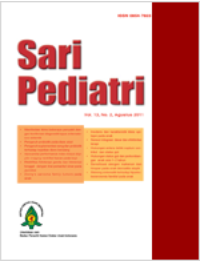Kualitas Hidup Anak dengan Hemofilia di Rumah Sakit Dr. Cipto Mangunkusumo
Sari
Latar belakang. Hemofilia merupakan salah satu penyakit kronik yang dapat memengaruhi kualitas hidup.
Tujuan. Mengetahui prevalensi, gangguan kualitas hidup, kesesuaian kualitas hidup berdasarkan laporan anak dan laporan orangtua serta pengaruh faktor medis terhadap kualitas hidup anak hemofilia di RSCM.
Metode. Penelitian potong lintang pada pasien hemofilia usia 5-18 tahun di Poliklinik Hematologi Departemen Ilmu Kesehatan Anak RSCM selama September-Desember 2016. Pengisian kuesioner PedsQLTM 4.0 dilakukan dengan wawancara. Faktor risiko dianalisis secara multivariat.
Hasil. Gangguan kualitas hidup menurut laporan anak 52,9% (rerata 64,37±11,75) dan menurut orangtua 60,8% (rerata 64,37±13,87) dari total 102 anak hemofilia. Dimensi yang paling terganggu adalah dimensi fisik menurut kelompok 5-7 tahun, sedangkan menurut kelompok 8-18 tahun adalah dimensi fisik dan sekolah. Terdapat ketidaksesuaian antara laporan kualitas hidup anak dan orangtua pada kelompok usia 5-7 tahun. Kekakuan sendi merupakan faktor risiko terjadinya gangguan kualitas hidup menurut laporan anak (p=0,005, RP 4,335, IK 95% 1,550-12,126) dan orangtua (p=0,04, RP 2,902, IK 95% 1,052-8,007).
Kesimpulan. Terdapat 52,9% (laporan anak) dan 60,8% (laporan orangtua) anak hemofilia yang kualitas hidupnya terganggu. Kekakuan sendi merupakan faktor yang paling memengaruhi kualitas hidup. Untuk menilai kualitas hidup anak usia 5-7 tahun diperlukan laporan anak dan orangtuanya, sedangkan anak usia 8-18 tahun cukup laporan anak atau orangtua saja.
Kata Kunci
Teks Lengkap:
PDFReferensi
Espaldon AMD, Hernandez FG. Health-related quality of life assessment in Filipino children with hemophilia aged 4 To 16 years in a tertiary hospital. J Hematol Thromb Dis 2014;2:1-6.
Gringeri A, Mackensen SV, Auerswald G, Bullinger M,Garrido RP. Health status and health-related quality of life of children with hemophilia from six West European countries. Haemophilia 2004;10:26-33.
Varni JW, Seid M, Skarr D, Burwinkle TS. Health status assessment project. Data Insight Report Children’s Health Assessment Project 2002;10:1-12.
Gatot D, Moeslichan S. Gangguan pembekuan darah yang diturunkan. Dalam: Permono HB, Sutaryo, Ugrasena IDG, Windiastuti E, Abdulsalam M, penyunting. Buku ajar hematologi. Edisi ke-3. Jakarta: Badan Penerbit IDAI; 2010.h. 174-7.
Poon JL, Zhou ZY, Doctor JN, Wu J, Ullman MM, Ross C, dkk. Quality of life in haemophilia A: hemophilia utilization group study Va (HUGS-Va). Haemophilia 2012;5:699-707.
Poon JL, Doctor JN, Nichol MB. Longitudinal changes in health-related quality of life for chronic disease: an example in hemophilia A. J Gen Intern Med 2014;29:760-6.
Shapiro AD, Donfield SM, Lynn HS, dkk. Defining the impact of hemophilia: the academic achievement in children with hemophilia study. Pediatrics 2001;108:1-6.
Ziliwu TK. Kualitas hidup anak dengan hemofilia dan faktorfaktor
yang mempengaruhinya di bagian IKA RSUP Dr. Sardjito Yogyakarta [Tesis]. [Yogyakarta]: Universitas Gajah Mada; 2012.
Mercan A, Sarper N, Inanır M, dkk. Hemophilia-specific quality of life index (Haemo-QoL and Haem-A-QoL questionnaires) of children and adults: result of a single center from Turkey. Pediatr Hematol Oncol 2010; 27:449-61.
Taha MY, Hassan MK. Health-related quality of life in children and adolescents with hemophilia in Basra, Southern Iraq. J Pediatr Hematol Oncol 2014;36:179-84.
Holmbeck GN, Johnson SZ, Wills KE, dkk. Observed and perceived parental overprotection in relation to psychosocial adjustment in preadolescents with a physical disability: the mediational role of behavioral autonomy. J Consult Clin Psychol 2002;70:96-100.
Bagheri S, Beheshtipoor N, Rambod M, Karimi M, Zare N, Hashemi F. The quality of life of children with hemophilia in Shiraz, Iran. IJCBNM 2013;1:110-20.
Gringeri A, Mackensen SV. Quality of life in hemophilia. Hemophilia. 2008;14:19-25.
Janse AJ, Sinnema G, Uiterwaal CSPM, Kimpen JLL, Gemke RJBJ. Quality of life in chronic illness: children, parents and paediatricians have different, but stable perceptions. Acta Paediatr 2008;97:1118-24.
Eiser C. Children’s quality of life measurement. Arch Dis Child 1997;77:350-4.
Eiser C, Eiser JR, Stride CB. Quality of life in children newly diagnosed with cancer and their mothers. Health Qual of Life Outcomes 2005;3:29-34.
Varni JW, Limbers CA, Burwinkle TM. How young can children realibility and validity self-report their health-related quality of life?: an analysis of 8,591 children across age subgroup with the PedsQLTM 4.0 generic core scales. Health Qual of Life Outcome 2007;5:1-13.
Brown TM, Lee WC, Joshi AV, Pashos CL. Health-related quality of life and productivity impact in haemophilia patients with inhibitors. Haemophilia 2009;15:911-7.
Scalone L, Mantovani LG, Mannucci PM, Gringeri A. Quality of life is associated to the orthopaedic status in haemophilic patients with inhibitors. Haemophillia 2006;12:154-62.
Centers for disease control and prevention. Hemophilia: data and statistics. [Diakses tanggal 1 November 2016]. Didapat dari: https://www.cdc.gov/ncbddd/hemophilia/data.html.
Trippoli S, Vaiani M, Linari S, Longo G, Morfini M, Messori A. Multivariate analysis of factors influencing quality of life and utility in patients with hemophilia. Haematologica 2001;86:722-8.
Net JVD, Vos RC, Engelbert RHH, Berg MHVD, Helders PJM, Takken T. Physical fitness, functional ability and quality of life in children with severe haemophilia: a pilot study. Haemophilia 2006;12:494-99.
Mazloum V, Rahnama N, Khayambashi K. Effects of therapeutic exercise and hydrotherapy on pain severity and knee range of motion in patients with hemophilia: a randomized controlled rial. Int J Prev Med 2014;5:83-8.
Mazloum V, Khayabash KH, Rahnama N. Comparing the effects of therapeutic exercise and hydrotherapy on pain severity and knee range of motion in patients with hemophilia: a randomized controlled trial. Armaghane danesh 2013;18:430-41.
Heijnen L, Buzzard BB. The role of physical therapy and rehabilitation in the management of hemophilia in developing countries. Semin Thromb Hemost. 2005;31:513-7.
Saxena K. Barriers and perceived limitations to early treatment
of hemophilia. J Blood Med 2013;4:49-56.
Zhou ZY, Riske B, Forsberg AD, Ullman M, Baker JR, Koerper MA, dkk. Self-reported barriers to hemophilia care in people with factor VIII deficiency. Am J Prev Med 2011;41:346-53.
Ferreira AA, Leite ICG, Teixeira MTB, Correa CSL, Cruz DTD, Rodrigues DOW, dkk. Health-related quality of life in hemophilia: result of the hemophilia- specific quality of life index (Haem-A-QoL) at Brazilian blood center. Rev Bras Hematol hemoter 2013;35:314-8.
DOI: http://dx.doi.org/10.14238/sp21.2.2019.73-80
Refbacks
- Saat ini tidak ada refbacks.
##submission.copyrightStatement##
##submission.license.cc.by-nc-sa4.footer##
Email: editorial [at] saripediatri.org


Sari Pediatri diterbitkan oleh Badan Penerbit Ikatan Dokter Anak Indonesia
Ciptaan disebarluaskan di bawah Lisensi Creative Commons Atribusi-NonKomersial-BerbagiSerupa 4.0 Internasional.




